Succulents are a Great Choice for Garden Railroads
Let’s talk about the “garden” part of garden railroading. A well thought out garden design can add interest to your railroad, minimize maintenance, and provide additional opportunities to enjoy the hobby. If you visited our latest garden railroad display at the Sn Diego County Fair, you saw first-hand how succulents can complement and enhance a model railroad layout.
Succulents have become a favorite among local gardeners for their low maintenance requirements and visually striking appearance. They come in an endless variety of shapes, colors and sizes, making them perfect candidates for a garden railroad layout. Some of the advantages of succulents over other plant choices include:
- Low Maintenance: Succulents are known for being resilient and adaptable to various environmental conditions. This hardiness makes them ideal for outdoor garden settings where they can withstand heat, drought and moderate exposure to the elements. Their minimal care requirements mean you can spend more time enjoying your garden railroad and less time tending demanding plants.
- Space Efficiency: Since succulents generally have shallow root systems, they don’t require large pots or deep planting areas. They can be easily moved as your layout is changed. This space efficiency is particularly good for incorporating them into compact garden railroad designs.
- Aesthetic Diversity: From the green paddle-shaped leaves of the common jade plant to the beautiful burgundy rosettes of an Aeonium ‘Swartkop’, succulents offer a variety of shapes, colors, and textures. Their unique appearance adds character and variety to your garden railroad, helping you create the perfect desert scene, a lush garden paradise, or beautiful forested mountains.
Choosing the best succulent species to complement your garden railroad will depend on the theme of your layout, exposure (shade/part shade/full sun), and personal preference. While no two railroads are the same, there are numerous succulent species that could be appropriate for your layout. These are just a few of my favorites:
Forest Scenes
Bonsai Crassula (Crassula sarcocauis) is a small tree-ike succulent with dark stems, medium green leaves and small pink or white flowers in the summer. Bonsai crassula is heat and cold tolerant (to about 10 deg F) and can grow to 12-18 inches tall and wide.
Miniature Pine Tree (Crassula tetragona) is an upright succulent with woody brown stems and crossed pairs of green leaves. White flowers come out in the summer. This plant prefers full sun, is easy to propagate from cuttings, and can grow to approximately 2 feet tall.
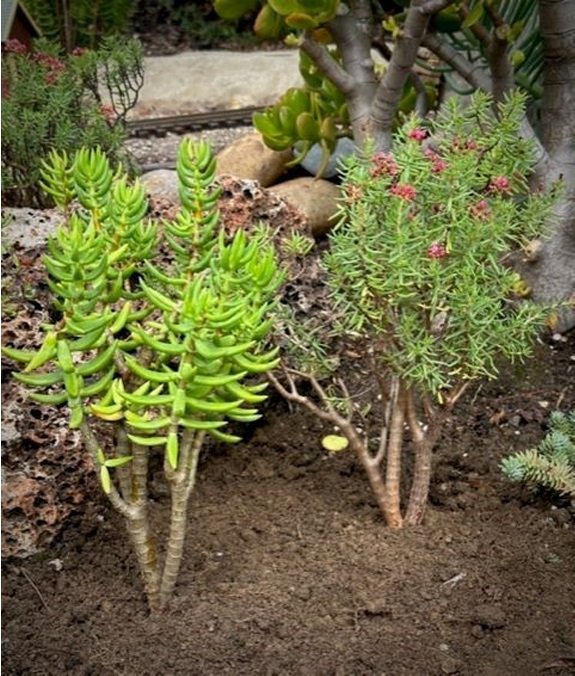
Adding Color
Aeonium ‘Swartkop’ is an easy to cultivate shrub-like succulent with bold, dark burgundy rosettes growing up to 6-8 inches in diameter. This aeonium prefers full sun but can tolerate light shade as well. They can reach 3-4 feet tall and often go dormant in the summer.
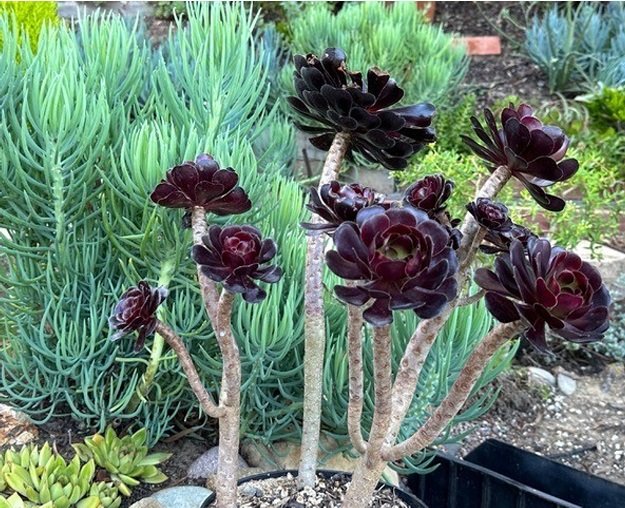
Fire Sticks (Euphorbia tirucalli ‘Sticks on Fire’) form a large shrub of loosely branching vertical stems. The stems change colors from light green to yellow/orange to bright red as the seasons change. They can grow up to 4-8 feet tall and be pruned as needed. This plant prefers full sun and does well in poor soils. NOTE: The sap from this plant is corrosive. Take care to avoid exposure to skin, eyes and pets.
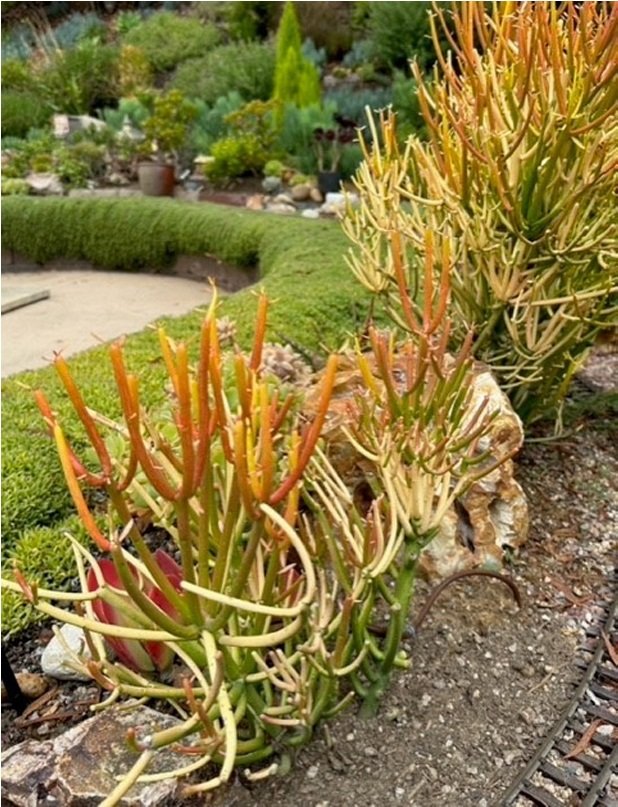
Ground Cover
Dwarf Carpet of Stars (Ruschia ‘Nana’) is a hardy succulent that grows as a blanket of green, crisscrossed, fleshy, 3-angled leaves. Small pink or purple flowers show up in spring or early summer attracting local pollinators. It is often used as a lawn alternative and thrives in full or part sun.
Desert Scenes
Short-leaved Aloe (Aloe brevifolia) is a low growing, clumping aloe featuring short, fat, toothed leaves. The short-leaved aloe forms tight rosettes that spread horizontally. While mostly green overall, the leaves can turn red in direct sunlight. They prefer full sun and can get from 1-2 feet tall and wide.
Zebra Plant (Haworthiopsis fasciata) is often considered an indoor plant, but it also does well in protect, shaded outdoor areas. They’ll grow up to 5 inches tall and form clumps up to 8 inches wide. Leaves are dark green with raised white strips on the outside.
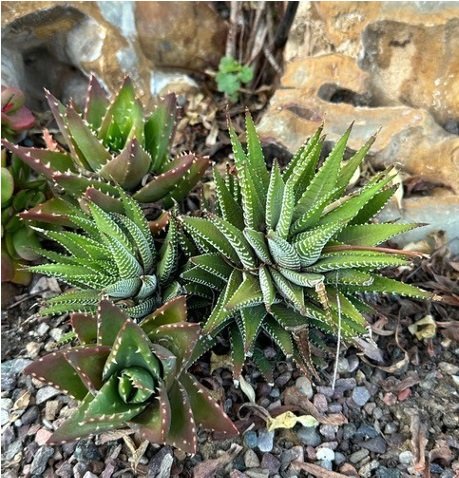
Dune Gasteria (Gasteria acinacifolia) is drought and shade tolerant and does well outdoors. It has thick, stacked leaves that are typically green but will turn red in bright light. It will grow approximately 12 inches tall and wide. This gasteria will produce a long stalk of pink/orange flowers that are favored by hummingbirds.
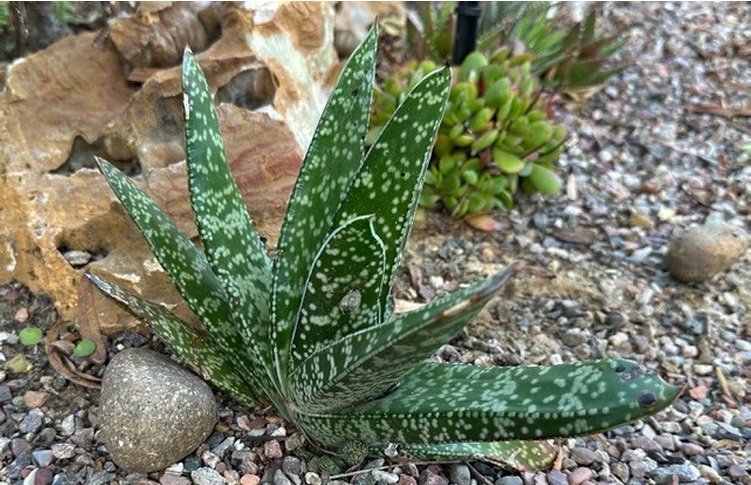
Vertical Filler
Narrow Leaf Chalk Sticks (Senecio cylindricus) is a shrub-like succulent with slender gray-green upturned leaves that circle the stems forming tufts at the ends. These plants grow up to 2 feet tall and can spread up to 5 feet wide. They are very drought tolerant and do well in full or partial sun. This senecio is a fast grower and easy to propagate.
Layout Design
If you don’t already have a layout, this is the perfect time to plan your garden railroad with succulents in mind. Incorporate elevated areas, gentle slopes, and rocky terrains where succulents can thrive. If you have an existing layout, look for areas that need refreshing or where you’d like another point of interest. Once you know where the new plants will go, take a moment to decide how you’ll bring water to the succulents, especially if they’ll require a different watering schedule than the existing plants.
Plant Selection
Research different succulent varieties and choose those that complement the theme of your garden railroad. There is tremendous variety of succulent species available in the San Diego area. Wander the aisles of your local nursery to get more ideas. I’ve found some great options at Walter Anderson Nursery in Poway and our local home Depot. Check the plant tags before you buy to make sure your new succulent is compatible with the light conditions in your layout.
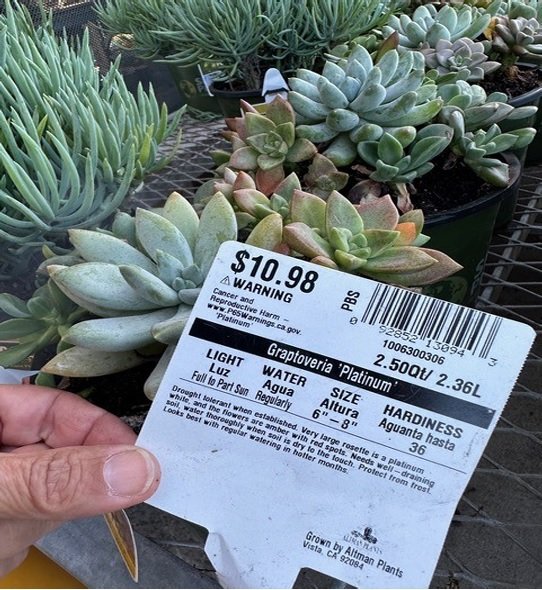
Soil
Succulents need well-draining soil to avoid root rot. Overwatering is the most common problem that new growers encounter. If your current soil doesn’t drain well, consider mixing succulent potting mix with the existing soil where you’re planting. I’ve found that amending the top 5-8 inches of soil around a new plant helps it drain well and root successfully. There are many brands of succulent soil available locally and on-line. E.B. Stone Cactus and Succulent Mix is one of my favorites, it has a nice balance of organic and coarse material. I often add pumice (available at your local nursery) to the potting mix (1 part pumice to 3 parts potting mix) to improve drainage even more.
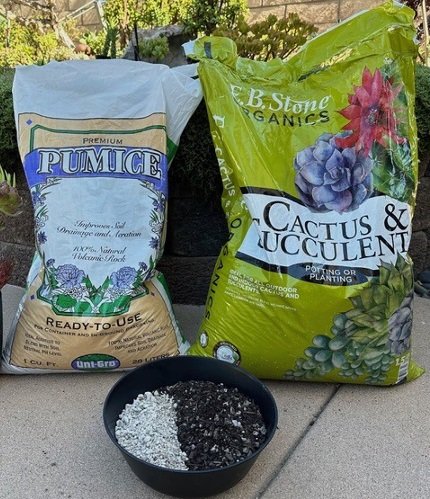
Watering
Even though succulents are drought tolerant, routine watering is still required, especially in the summer. The key is to avoid overwatering your succulents. Remember to let the soil dry out between watering. Using a low-flow drip irrigation system with a timer can provide the right amount of water directly to the roots. These systems offer multiple dripper and sprayer options and are easy to set up and modify as your succulent collection grows. Be wary of adding the optional soaker hoses to your drip system. We found that the soaker hoses attracted thirsty canyon critters from the other side of our fence. Field mice, etc. would regularly chew through the hoses. Swapping the soaker hoses for dripper and sprayer heads fixed the problem.
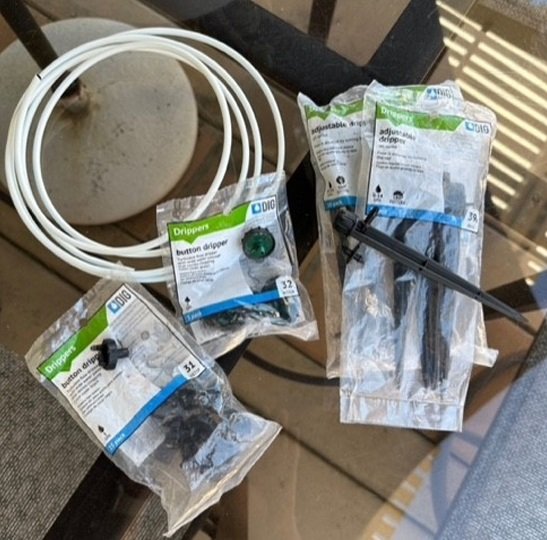
Fertilizing
Outdoor succulents generally don’t require additional feeding if they’re planted in healthy soil. But if the soil is lacking nutrients, there’s little downside to occasional fertilizing. It’s best to use a product formulated specifically for succulents or cacti to avoid burning the plant (succulents are sensitive to high nitrogen content fertilizers). Just follow the directions on the package. I’ve tried fertilizing our succulents off and on over the years with mostly positive results.
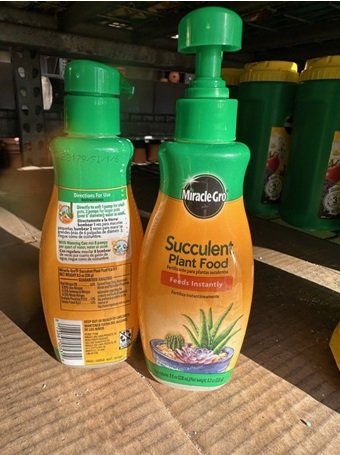
Maintenance and Tools
Once your plants are in place and growing happily, you’ll need to trim them back occasionally to maintain the scale of your layout. I use basic garden pruners for much of this work but have found that our cordless Ryobi hand-held grass trimmer works wonders to keep our ground cover away from the tracks.
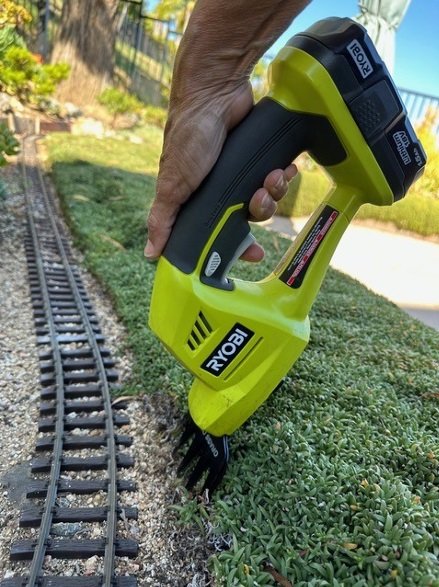
You might also find a random weed or two hiding among your succulents. A Japanese Hori-Hori knife can make weeding almost effortless. It’s a great all-around tool that’s good for digging, planting, and even cutting small branches. Once you have one, you’ll find all kinds of uses for it. Finally, a pair of long-sleeved gardening gloves comes in handy when you work around succulents with sharp spines or corrosive sap.
These are just a few tips to get you started. So much more can be learned by simply giving succulents a Try. Our San Diego climate is ideal for incorporating these plants in your garden railroad.
